By Dr. Eshwer Kale
The world is today facing an unprecedented water crisis, both in access and availability. Cape Town in South Africa reached ‘day zero’ water status in 2018. India, according to the NITI Aayog, is facing the worst water crisis in its history, with an estimated 600 million people having to deal with high to extreme water scarcity[1]. Twenty-one major Indian cities are likely to run out of groundwater by 2020. This statistic is just the tip of ice berg, and the situation is projected to become even worse if appropriate actions are not taken. This is true, not just for India but for the world as a whole.
Along with water crises, climate change or climate variability and its effects in terms of extreme events and slow onsets as well as climate loss and damages, are the biggest threat to all type of life on the earth. Increasingly erratic weather patterns are having adverse impacts on human life and overall ecosystems. The context of climate change, where 2°C temperature rise is expected by the end of the 21st century, is creating many challenges.[2]
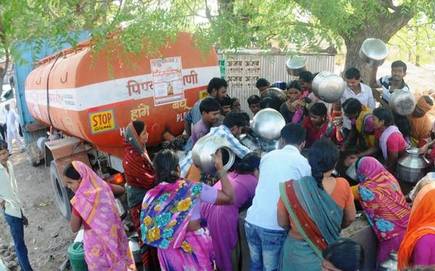
People queuing up behind a water tanker. Source: Hindu Business Line
To take one example, In Maharashtra, a recent report of the Groundwater Surveys and Development Agency (GSDA) indicates that in the past 5 years, of the 353 blocks in the state, in 230 blocks the water level dropped by 1 to 3 meters.[3] During 2018-19, the government of Maharashtra declared drought in almost half of Maharashtra’s talukas (151 of 353 talukas). In thousands of villages, people are struggling to get potable water through government supplied tankers. [4]
1. Factors responsible
Multiple natural and anthropogenic factors are responsible for the occurrence of these adverse conditions. For growing water scarcity and depletion of groundwater, although changing rainfall regime because of climate change is seen is seen as one of the important reasons, the unrestricted and unlimited groundwater extraction for cash crops, low water use efficiency in irrigation and inappropriate water practices by all type of water users are major other contributing factors. It is widely accepted that for changes in climate and resultant global warming, anthropogenic factors in terms of inappropriate human practices and actions are responsible for making the situation worse. Food wastage, by all of us at different levels, is one of the causes for this problem.
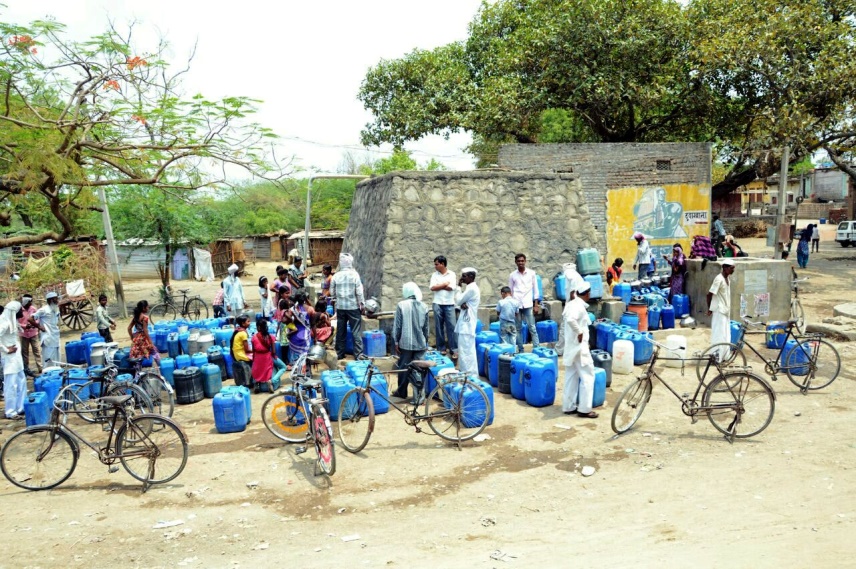
Villagers in Maharashtra waiting for tankers. Source: Digambar Sonwane
1.2 Food loss and waste
Many of us may be unaware of the amount of food we waste and how this contributes to water scarcity and climate change. Food waste or food loss is ‘food that is discarded or lost uneaten’, in simple words it is the amount of food that gets produced but does not get consumed. We can easily see lots of food waste occurring at our homes and places we go to. But the bigger picture is more worrying, as the bulk of food loss occurs throughout the entire journey that food makes from the farms, through storage, processing, transport, market and finally to our homes. (http://eschooltoday.com/global-food-waste-and-food-loss/what-is-food-waste.html). In short, as explained by Parfott, food losses occurring at the end of the food cycle.
2. The magnitude of food waste
The 2011 FAO assessment of global food losses and waste estimated that each year, one-third of all food produced in the world get wasted, which amounts to about 1.3 billion tons per year. [5] This mainly happens in food processing, packaging, transporting, marketing, and mores significantly throwing away the uneaten cooked food. As described in following figure, among the different food type, fruits and vegetables, cereals and meat items are those which mostly left out uneaten which go wasted. Food use and consumption pattern is an important factor in deciding the amount of food waste we generate.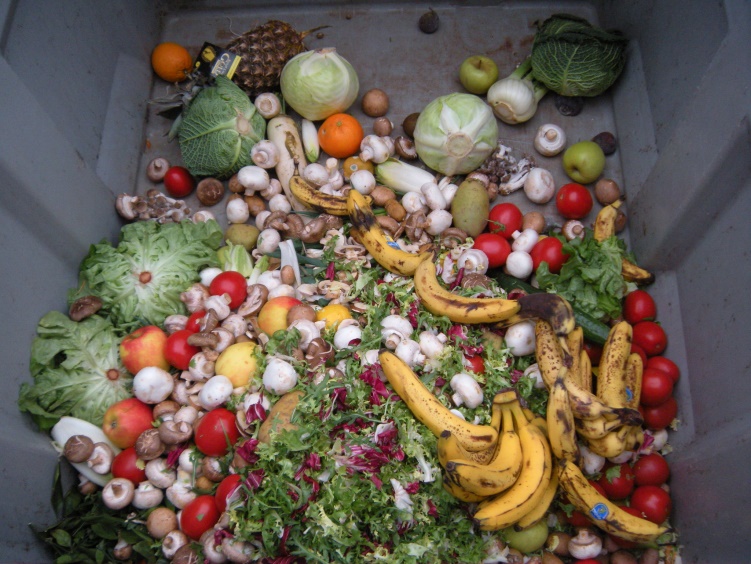
A picture of food wastage.
The following figure describe the annual amount of food getting wasted by individuals in different countries:

Source: https://www.care2.com/greenliving/which-countries-waste-the-most-food.html
2.1 Food waste in India
When it comes to India, Indians waste as much food as the United Kingdom consumes. According to the United Nations Development Programme, up to 40% of the food produced in India gets wasted. According to another statistic, about 21 million tonnes of wheat get wasted in India. [6] Weddings, canteens, hotels, social and family functions, households are the important places where vast quantities of food get wasted. In medium- and high-income countries food is often wasted at the consumption stage; the food is discarded even if it is still suitable for human consumption.
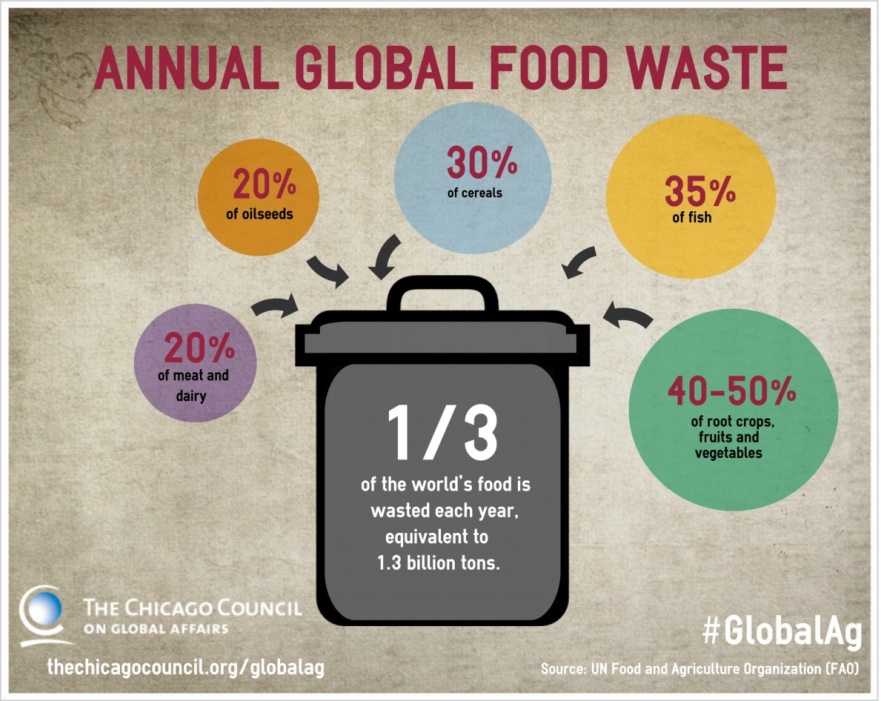
- Food waste=waste of water
Water is the primary resource which is required for any type of production and services. The amount of water used to produce each of the goods and services we use is called as water footprint. Thus, when we import or export or consume or waste any item or service, we directly deal with the virtual water being used to produce that particular item or service. Therefore, the amount of food waste inevitably also means that huge amounts of the resources used in food products such as water, chemical and pesticides, harvesting, processing, packing material used are in vain or also wasted. For example, when we throw away an apple, we are practically wasting 70 litres of water.
In much the same way, to produce 1 kilogram of wheat requires 1,000 litres of water, so when we waste 1 roti of wheat we waste more than 35 litres of water.
The water footprint of producing all sort of meats is very high. For example, to produce 1 kg of beef, it takes 4,127 liters of water; [7] so one can imagine, the amount of water we consume when we discard meat. The figure of virtual water indicates the water contained in different eatable items.
According the studies, 25% of fresh water used to produce food is ultimately wasted, even as millions of people globally still don’t have access to drinking water. [8]
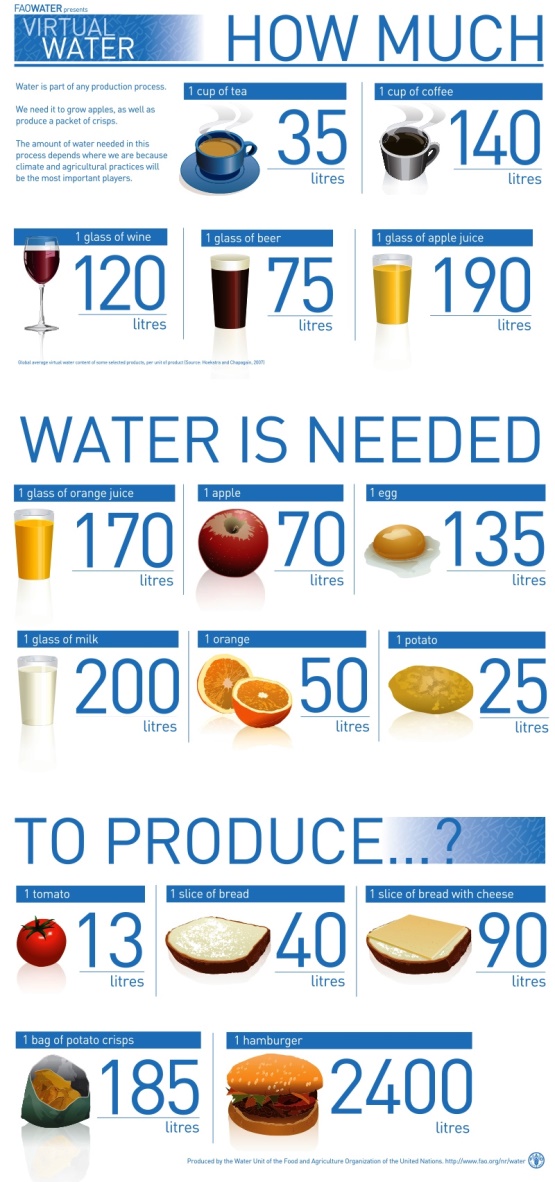
The above table gives us an idea of the amount of water required to produce different commodities.
- Food loss and climate change
Wasted food isn’t just a waste of resources or a social or humanitarian concern, but it has important implications for our environment. When we waste food, we also waste all the energy, water and material it takes to grow, harvest, transport, and package it. When consuming all these resources, if food goes to the landfill and rots, it produces methane, a greenhouse gas even more potent than carbon dioxide. Carbon dioxide, methane, nitrous oxide and hydrofluorcarbons (fluorinated gases used in refrigeration) are produced and emitted. [9] It is evident that about 11% of all the greenhouse gas emissions that come from the food system could be reduced if we stop wasting food.[10]
By throwing away half of the cooked food, half of the emissions that resulted from producing and processing, packaging, shipping, storing, picking up and cooking are also wasted. The contribution of food waste in globing warming is significant.

As indicated in the below figure, if food waste were a country, it would come in third after the United States and China in terms of impact on global warming. Therefore, sustainable food consumption needs to be seen as an important strategy to mitigate with growing climate change.
- Food loss and waste and SDGs
Food loss and waste has close relevance to achieve few important Sustainable Development Goals (SDGs). All efforts to reduce the waste of foods at different level, from individual to institutions, leads towards achieving SDG 12 which aims to ensure the sustainable consumption of resources and production patterns. This goal specifically talks about the reducing the water footprint and the per capita global food waste at the retail and consumer levels and reduce food losses along production and supply chains. Along with this, reducing the food waste is as in important strategy to achieve SDG 2 of ending the hunger and SDG 13 of initiating the urgent action to combat climate change and its impacts.
- How to minimize food waste
For minimizing the existing amount of food loss and waste at different phases such as harvesting, processing, packing, and marketing as well as at dining tables, multiple actions needs to be taken. Specific policy interventions, technological innovation, and innovative business models will certainly reduce the food loss till it comes to our food bucket. However, thereafter responsibilities of avoiding food waste comes to an individual, family and places where collective cooking take place such as hotels, restaurants, mess, and different type of public functions. As, an individual is a last consumer of food at all places), food use behavior of an individual is important in deciding the sustainable food use or its waste.
At individual level:- The key strategy at an individual level has to be adopted is to follow the sustainable food habits and consumption pattern. Here an individual must follow the practices of serving his food plate where he or she can have a total quantity of food served. Therefore, we must make a habit of finishing our plate, not only at our home but even in hotels, restaurants and public functions.
It also necessitates, planning and following our diet pattern where many of us take over food, resulting in problem of either over weight or obesity.
At family level:-In family, we can certainly make a choice of following certain practices, such as,
- Planning out our meal and make a shopping list to determine what we actually need for the week.
- Avoiding impulsive buys and shopping. Buying in quantities we can realistically use, or else most of it will find the bin.
- If we cook at home, make sure we cook keeping in mind there is no excess.
- Using packed food before the expiry dates.
- Reusing the refrigerated left-overs (if any) for the very next meal.
At business unit and public functions:-Food that gets wasted at hotels, restaurants, as well as public functions and social events can be effectively reached to the needy people. While some restaurants in India employ food controllers to check food spoilage, others donate it to their staff and other personnel, and smaller standalone restaurants, donate it to street children and orphanages. This strategically needs to be scaled up drastically.
- Conclusion
Although food wastage is a global problem, India stands a chance to convert this into an opportunity. Many reports states that every third malnourished child is Indian and 194 million Indians go hungry daily.[12]
In light of this sad reality, if we address unsustainable food habits and consumption pattern and gaps in the logistics supply-chain, we can help bring down the wastage in food. It is easy way to shift the blame of for any problem onto others and ignore the contribution of one’s own self. Hence, to address the issue of food waste, individuals needs to make changes in their own lifestyle.
In Indian culture, food is treated as God and revered, best illustrated in the saying- ‘Ann he PurnBrahmha’ ; in many cultures, all over the world, people offer prayers before their meals. Such habits are important as they indicate that the food served in our plate has been ‘blessed’, subtly telling us not to waste it. Thus, the behavior of an individual and family as well as business units is important towards sustainable use of food. Therefore, at all levels, the approach of ‘As much as is required, but as little as possible’ needs to be adopted in our consumption and lifestyle pattern, to ensure sustainable use of all our precious natural resources.
References
[1] Roger P (2008), ‘Facing Freshwater Crises’, Scientific American: August 2008, is available at http://ohm.ecce.admu.edu.ph/wiki/pub/Main/ResearchProjects/Facing_the_Freshwater_Crisis_cientific_American.pdf
[2] CSR Journal, 31 October 2018, Food Wastage In India, And What You Can Do About It, available at https://thecsrjournal.in/food-wastage-in-india-a-serious-concern/
[3] Chad Frischmann, July 31, 2018, The climate impact of the food in the back of your fridge, The Washington Post, available at https://www.washingtonpost.com/news/theworldpost/wp/2018/07/31/food-waste/?noredirect=on&utm_term=.3428cf24d23d
[4] WWF, Fight climate change by preventing food waste, available at https://www.worldwildlife.org/stories/fight-climate-change-by-preventing-food-waste
[5] CSR Journal, 31 October 2018, Food Wastage In India, And What You Can Do About It, available at https://thecsrjournal.in/food-wastage-in-india-a-serious-concern/
[6] FAO, 2011, Global Food Losses and Food Waste, Report available at http://www.fao.org/3/a-i2697e.pdf
chain (retail and final consumption) are called “food waste”, which relates to retailers and consumers behavior.[1]
[7] Parfitt et al., 2010, Food Waste within Food Supply Chains: Quantification and Potential for Change to 2050, Philosophical Transactions of The Royal Society B Biological Sciences 365(1554):3065, DOI: 10.1098/rstb.2010.0126
[8] The Economic Times, available at https://economictimes.indiatimes.com/news/politics-and-nation/maharashtra-declares-drought-in-151-talukas/articleshow/66451212.cms?from=mdr
[9] NITI Aayog, 2018, Report on ‘Composite Water Management Index’, available at http://pibphoto.nic.in/documents/rlink/2018/jun/p201861401.pdf
[10] IPCC, 2014, Climate change 2013: the physical science basis (eds: Stocker TF et al). Cambridge University Press, Cambridge, UK
[11] GSDA,2017, Comparative study of water levels in Oct 2017. Report submitted by Groundwater Survey and Development Agency to Government of Maharashtra, Water and Sanitation Department
[12] The Hindu, May 2015, available at https://www.thehindu.com/news/national/india-is-home-to-194-million-hungry-people-un/article7255937.ece





